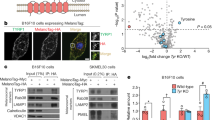Abstract
The melanosome is a secretory organelle unique to the melanocyte and its neoplastic counterpart, malignant melanoma. The synthesis and assembly of these intracytoplasmic organelles is not yet fully understood. We have developed a murine monoclonal antibody (MoAb) against melanosomes isolated from human melanocytes (newborn foreskin) cultured in the presence of 12-O tetradecanoyl phorbol-13-acetate (TPA). This MoAb, designated HMSA-5 (Human Melanosome-Specific Antigen-5) (IgG1), recognised a cytoplasmic antigen in both normal human melanocytes and neoplastic cells, such as common and dysplastic melanocytic nevi, and malignant melanoma. None of the carcinoma or sarcoma specimens tested showed positive reactivity with MoAb HMSA-5. Under immunoelectron microscopy, immuno-gold deposition was seen on microvesicles associated with melanosomes, and a portion of the ER-Golgi complexes. Radioimmunoprecipitation analysis showed that the HMSA-5 reactive antigen was a glycoprotein of M(r) 69 to 73 kDa. A pulse-chase time course study showed that the amount of antigen detected by MoAb HMSA-5 decreased over a 24 h period without significant expression on the cell surface, or corresponding appearance of the antigen in the culture supernatant. This glycoprotein appears to play a role in the early stages of melanosomal development, and the HMSA-5 reactive epitope may be lost during subsequent maturation processes. Importantly, HMSA-5 can be identified in all forms of human melanocytes, hence it can be considered a new common melanocytic marker even on routine paraffin sections.
This is a preview of subscription content, access via your institution
Access options
Subscribe to this journal
Receive 24 print issues and online access
$259.00 per year
only $10.79 per issue
Buy this article
- Purchase on Springer Link
- Instant access to full article PDF
Prices may be subject to local taxes which are calculated during checkout
Similar content being viewed by others
Author information
Authors and Affiliations
Rights and permissions
About this article
Cite this article
Der, J., Dixon, W., Jimbow, K. et al. A murine monoclonal antibody, MoAb HMSA-5, against a melanosomal component highly expressed in early stages, and common to normal and neoplastic melanocytes. Br J Cancer 67, 47–57 (1993). https://doi.org/10.1038/bjc.1993.8
Issue Date:
DOI: https://doi.org/10.1038/bjc.1993.8



